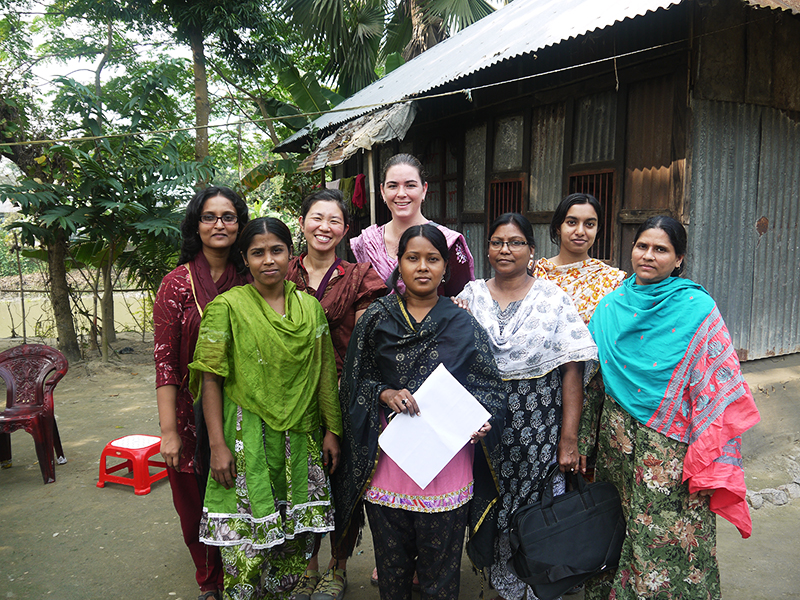
Elisabeth Root (center back) and her team have been collecting data in a number of households in Bangladesh for the last six years. Credit: Courtesy of Nobuko Mizoguchi
In order to better understand children’s health beyond biological mechanisms, Ohio State researchers looked at the socioeconomic situations that place children and their families in high-risk health categories.
Elisabeth Root, an associate professor in the Department of Geography, has been collecting data on the health outcomes of children and families in Bangladesh through household surveys for the past six years. Root said she wanted to find out why children get sick in developing countries and how the team of researchers can help improve children’s health in the developing world.
In each household, Root and her team not only measured height, weight and lung function, as well as the blood pressure of each family, but they also asked questions about what level of education the mothers have received, how wealthy the household is and the jobs that people have in each household. They tried to put together the “two sides of the coin” to understand the whole situation, Root said.
“When I started traveling to other countries as a graduate student, I realized that there are a lot of parents struggling with how to raise healthy and happy kids,” Root said. “It tugged at my heartstrings a little bit because I’m also a mom of two kids.”
Root focused on many social and behavioral factors, rather than focusing solely on biological factors, to see how they predict whether a child is healthy.
Along with looking into what factors determine a family’s socioeconomic status, the team asked the mothers about pressure problems, such as economic stress, Root said.
“If a mother is depressed, then that typically leads to poor health outcomes among children,” Root said. “Because they rely on their mother to be healthy and happy individuals. So we do depression health surveys on moms.”
She said researchers interviewed the head of household and all of the family members in every household. There are 3,000 to 4,000 questions per person in this dataset, which leads to a massive amount of information, or “big data.”
There is always a debate in the field of data science about what is big data, Root said. When a lot of people think about big data, they think of platforms, such as Twitter, that produce billions of records of information each year.
But Root said big data is not about the quantity of information but rather the quality of information and how people can pass through all the information and come up with a good message about what is affecting children’s health.
“We have a tremendous amount of information on a single individual,” Root said. “But the question is, if I am interested in one health outcome, such as the respiratory health among moms and babies, what of all the information that I’ve collected is important in understanding respiratory health? To me, that’s a really big data question.”
Emelie Bailey, a graduate student studying geography who has worked on one of Root’s projects in Honduras, agreed that it requires careful mining of data when dealing with those large amounts data.
Part of Bailey’s project was to use the data from demographic and health surveys done in Honduras in 2005 and 2011 to see whether there has been a difference in health care access and outcomes for women as a result of the health system decentralization in some parts of the country.
“The total size of the 2011 (demographic and health surveys) data is about 20,000 people,” Bailey said. “It is quite large. What’s really important is being able to use and situate the variables that we get from this large data set within a country context — politically, socially, economically, and also at the community level.”
Recently, Root has also been working on collaborating with the state office of the Department of Health, which has a lot of big data on populations of Ohio and the health of those populations. Root said they will use their data to help make mothers and their babies healthier here in Ohio, too — for instance, by looking at preterm birth.
Women and children are two groups that are really affected by poor health systems and lack of access to resources, Bailey said.
“You realize that kids have no way of coping with that,” Root said. “It’s our responsibility as adults to help children be healthy and learn to do all different things. They can’t do it by themselves. They are the most vulnerable population on the planet, I think.”


